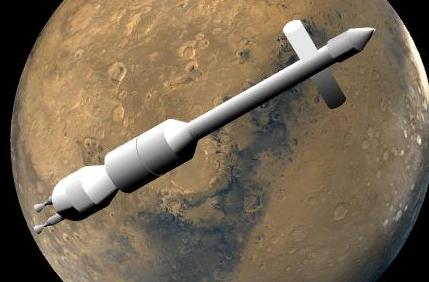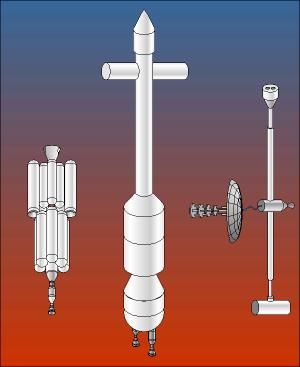
Home - Search - Browse - Alphabetic Index: 0- 1- 2- 3- 4- 5- 6- 7- 8- 9
A- B- C- D- E- F- G- H- I- J- K- L- M- N- O- P- Q- R- S- T- U- V- W- X- Y- Z
EMPIRE General Dynamics

Empire
General Dynamics Empire concept
Credit: © Mark Wade
AKA: Early Manned Planetary - Interplanetary Roundtrip Expedition. Status: Study 1962. Thrust: 1.78 kN (401 lbf). Gross mass: 900,000 kg (1,980,000 lb). Specific impulse: 800 s. Height: 95.00 m (311.00 ft). Diameter: 23.00 m (75.00 ft).
The 15-month mission would be launched toward Mars in March 1975.
EMPIRE was the first series of Mars mission studies conducted under NASA's auspices. The goal of the studies was to identify mission alternatives and estimate spacecraft masses for initial manned Mars flyby and orbiter missions. The primary objective was to identify payload requirements for Nova, the series of super heavy lift launch vehicles planned after the Saturn series. A secondary objective was to identify stage and engine requirements for NERVA, the AEC/NASA nuclear thermal engine program. The Marshall Space Flight Center's Future Projects Office, led by Heinz Koelle, let contracts for the studies to industry in May 1962. Three contractors were selected: Aeronutronic, General Dynamics, and Lockheed.
Krafft Ehricke led General Dynamic's EMPIRE team, and the result was an exhaustive study of Mars orbiter and even landing missions. GD proposed assembling the spacecraft in low earth orbit using multiple Saturn V or Nova launches. A crew of 8 would be sent on a 15-month Mars orbiter mission departing in March 1975. The crew would occupy the primary crew ship, but be accompanied by two service spacecraft. The service craft would provide a source of spares in the event of damage to the primary spacecraft during the voyage.
Four spacecraft configurations were considered in the final report:
- C-22, 106 m long, assembled from Nova-launched components with a 21 m diameter, and using near-term RIFT (55 metric ton thrust) or later NERVA (182 metric ton thrust) nuclear thermal engines. The spacecraft would be assembled in two launchings of 450 metric ton payload Nova boosters.
- C-23, 95 m long, assembled from Nova-launched components with a 23 m diameter, and using advanced nuclear thermal engines. The spacecraft would be assembled in eight launchings of 120 metric ton payload Saturn V boosters.
- C-26, 162 m long, assembled from Saturn V-launched components with a 10 m diameter, and using near-term RIFT (55 metric ton thrust) or NERVA (182 metric ton thrust) nuclear thermal engines.
- C-28, 174 m long, assembled from Saturn V-launched components with a 10 m diameter, and using advanced nuclear thermal engines.
A 3-m diameter, 23-m long spindle separated the crew spaces from the SNAP-8 nuclear power generator. During periods of coasting, the spacecraft would be spun up to provide the crew with 0.25 G of artificial gravity.
A number of robot probes would conduct research while the spacecraft was in Martian orbit. These included a Returner Mars sample collector, a Mars Lander (based on JPL's lunar Surveyor), impact probes (based on JPL's lunar Ranger) to investigate Phobos and Deimos, and a Mars Environmental Satellite orbiter. It was even suggested that the Returner could be modified to a two man Mars Excursion Vehicle, which would deliver two men to the Martian surface for a seven-day visit to the surface.
Crew Size: 8.
Family: Mars Expeditions, Mars flyby. Country: USA. Engines: Nerva-1. Propellants: Nuclear/LH2. Agency: Convair. Bibliography: 49, 591.
 | Empire Comparison Comparison of Empire designs, from left to right: Credit: © Mark Wade |
Back to top of page
Home - Search - Browse - Alphabetic Index: 0- 1- 2- 3- 4- 5- 6- 7- 8- 9
A- B- C- D- E- F- G- H- I- J- K- L- M- N- O- P- Q- R- S- T- U- V- W- X- Y- Z
© 1997-2019 Mark Wade - Contact
© / Conditions for Use